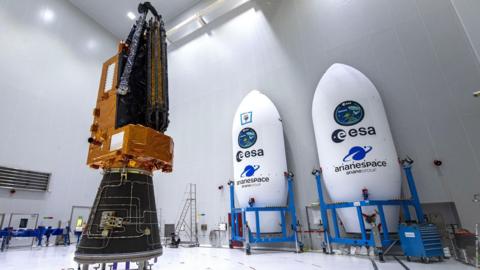The rocket took off from ESA's Kourou station in French Guiana and flying over the Amazon, one of the rainforests it will study.
The satellite on board has been affectionately named "space brolly" for its giant 12m diameter antenna which will send out signals.
"We really want to interrogate these forests. We can actually look inside," Prof John Remedios, director of The National Centre for Earth Observation, which proposed the idea to ESA, said after the launch.
He said that it would be a major achievement "to actually know for the first time with high accuracy how much is actually in the Amazon, Congo, Indonesia".
The antenna is using P-band radar which has a very long wavelength - allowing it to see deeper inside forests and reveal branches and trunks obscured by the canopy.
"Most radars that we have in space today take wonderful images of icebergs, but when they look at forests they see the tops of the forest, the little twigs, the little leaves, they don't penetrate down into the forests," explained Dr Ralph Cordey, head of geosciences at Airbus.
"But what we found was that by using a much longer radar wavelength, we could see down into the depths of trees and forests," he said.
The 1.2-tonne satellite will use an approach not dissimilar to that used in a CT scan, and analyse slices through the trees on repeat passes to build up a picture of how much woody material is present.
It is this material that can be used as a proxy for the amount of planet-warming carbon dioxide stored.
Currently scientists have been measuring individual trees and trying to extrapolate, but this presents a "huge challenge" said Prof Mat Disney, professor of remote sensing, at University College London.
"Our current understanding is really patchy, because it's really, really difficult to measure," he said. "Essentially, what we're talking about is trying to weigh the amount of carbon that's stored in one and a half trillion trees across the tropics.
"Satellites are really the only way you can do that consistently."
On the ground measurements will continue to take place after the satellite is launched to verify the data it is sending back.


